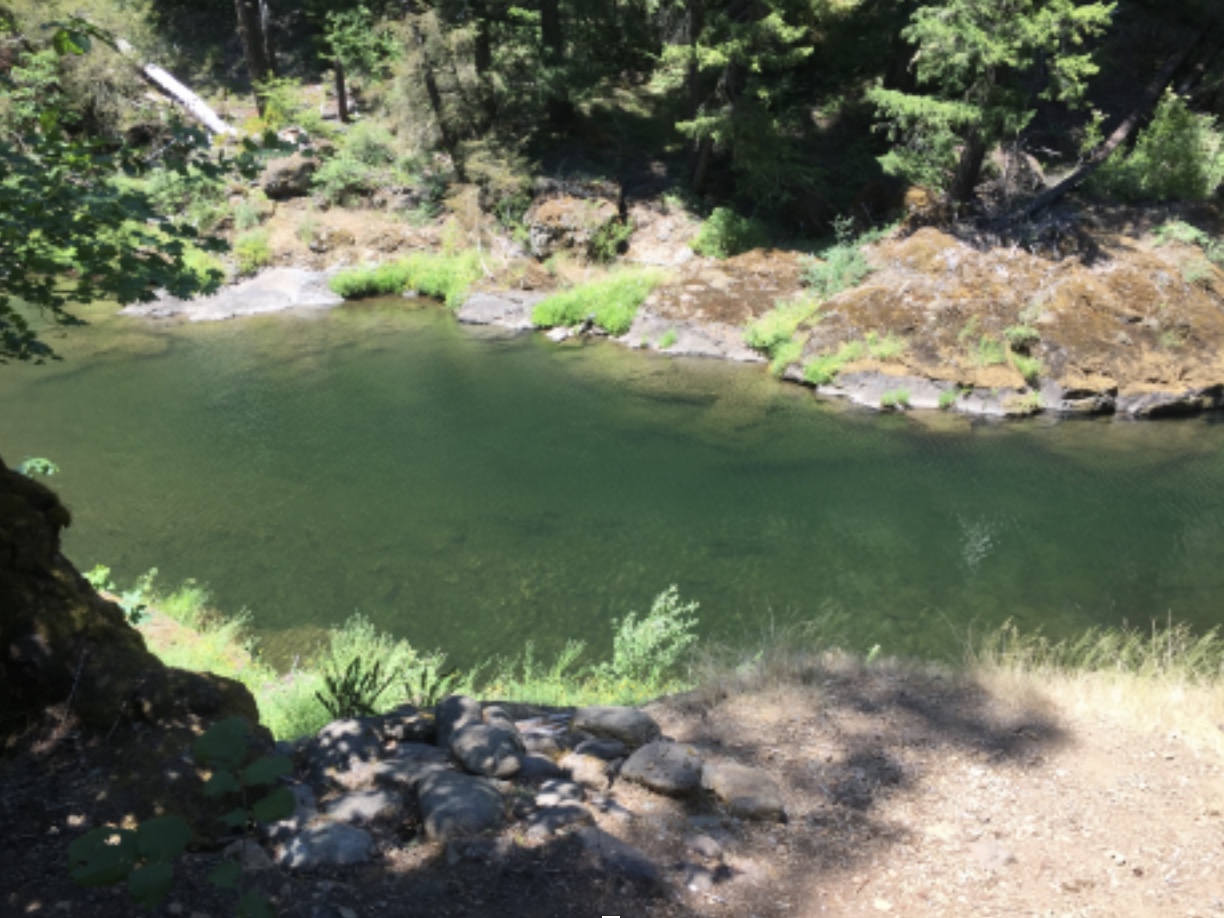FISHWATCH 2021 MONTHLY REPORT
June 2021
by Edward Kikumoto
Again this year, the U.S. Forest Service and The North Umpqua Foundation (TNUF) is asking the public to not visit the Pool due to Covid19 concerns, and to protect the health of the FishWatch Caretaker.
The opinions in this report are strictly my own, and do not reflect the views and opinions of the U.S. Forest Service, Oregon Department of Fish & Wildlife, The North Umpqua Foundation, or anyone else.
Greetings from the Big Bend Pool FishWatch 2021 Caretaker.
Statistics
No poaching activity, unlawful fishing, or harassment of the steelhead in the Pool observed in June.
At the beginning of June there were 3 steelhead in the Pool. At the end of June there were, approximately, 25 steelhead in the Pool. There were 100-visitors to the Pool while I was present at the Pool. There were no visitors while I was present during the first week, a few the following week, and then things started picking up thru the end of the month.
Reflections
June started out relatively cool with even a little rain, then it got hotter, and then hotter still.
The hottest day, in the last week of June at the Pool was 109ºF in the shade.
The temperature inside the Airstream hit 112ºF.
We are already experiencing late July and August temperatures and low water conditions.
The long term forecast is for highs in the 90s for the next 14-days with no rain in sight.
Needless to say I spent much of my time outside of the Airstream in the shade, which was at least a little cooler, and it helped when the wind blew. What is interesting, and what makes the heat this early tolerable is that there is a 40-degrees difference in temperature between night and day.
By midnight, the outside temperature will drop into the high 60s, and will go down into the low 60s, if not high 50s.
The Pool is at approximately 1,690-feet elevation, and has a unique micro climate.
If it gets as hot later in the summer, I don’t expect the temperature to drop so low at night.
I was taking water temperatures frequently during the hot spell, which you will find reported below.
Along with the heat came the bugs, of course, and particularly the horseflies, which the hotter it got the bigger they seemed to get.
The water level is lower than normal for this time of year.
It is already at mid-summer flow, which also means that steelhead wanting to reach the Pool may have some difficulty getting over Little Falls, which is at approximately Mile Post 1 (the Big Bend Pool is at Mile Post 10.2).
There was a decent downpour one early morning mid-month along with a few intermittent late afternoon showers.
It had almost no effect on the water level in the Pool.
A family of otters (4) came into the Pool during the last week of June. They were in the Pool sporadically during the week.
I’m assuming they have other places they visit, to feed on the abundant crawdads in the creek.
They tend to show up in the late afternoon or at dark.
They only disturb the steelhead to the extent that the steelhead keep their distance from them, and the otters don’t go out of their way to harass the steelhead in any way.
My presence, or rather my banging around (running the generator to charge the Airstream’s batteries, etc.) disturbs the otters and probably keeps them away somewhat.
Which during heat-waves, when the water temperature also goes up (and stresses the fish) isn’t necessarily a bad thing.
One less stressor is good.
On June 19, the Pool experienced very gusty winds in the afternoon. I heard two trees fall.
One was close upstream so I took a walk up to see if I could find it and to make sure that it didn’t fall onto the road and create a hazard.
I think I found it on the far-side, where a fallen dead tree appeared to have a freshly uprooted root-ball.
The other tree fell downstream somewhere and fell with a loud and sharp snap, then a single crash.
I think it was big.
Shortly thereafter vehicles came upstream so I assumed that it did not fall on the road.
The number of visitors to the Pool is increasing.
They are for the most part mindful of the closure notice and staying out of the viewing area; viewing the fish from the parking level (which is acceptable to me and better for the fish); and socially distancing while we talk.
I have had no more than four people at a time (and more often one or two) visit.
The undeveloped campgrounds along Steamboat Creek are full, particularly on the weekends.
The majority of the visitors to the Pool, however, are not the campers, but folks on day-trips making it a point to stop at the Pool.
Needless to say, during the heat-wave, a lot of folks came up to Steamboat Creek to swim.
Steamboat Creek is already warmer than 70ºF by mid-day.
The Forest Service firefighters are in the forest now, and will stop and visit, as well as USFS personnel doing other duties.
I am grateful that they’re around to help keep the forest a safe place. Which is true also for the visitors to the Pool – your [socially distanced] presence helps keep the steelhead in the Big Bend Pool safer.
Water temperatures
With the high daytime temperatures I have been taking more frequent water temperature readings.
I have also been monitoring the high and low air temperatures.
Why the concern?
The science is the higher the temperature the less oxygen in the water. The general rule for North Umpqua wild summer steelhead is they are the most comfortable in water temperatures below 64ºF, they are severely stressed at 68ºF, and will die if trapped in water 70ºF and higher.
Acronyms
BBC Big Bend Creek (spring cooled water)
BBP Big Bend Pool (the Pool)
LBP Little Bend Pool (1/4 mile downstream)
SC Steamboat Creek
The “low” and “high” numbers are air temperatures.
All water temperature numbers are Fahrenheit.
06.18.21 Friday
04:15 low 51ºF
12:00 high 85ºF in the shade
11:20 BBC 52.25-54.25
11:33 SC above BBC 62-64
11:49 Bottom of BBP 58-60
06.21.21 Monday
15:15 high 94ºF in the shade
18:30 “Little Creek” 61-62 (small stream coming into SC about 1/8 mile downstream of the Pool)
18:57 Richardson Creek 63-65
19:06 Johnson Creek 62-64 (very little flow)
19:20 SC below Johnson & Richardson 66-68
19:43 LBP 64-66 (halfway between Johnson & Richardson Creeks and the Big Bend Pool)
20:00 Bottom of BBP 64-66
20:13 BBC 59-61
20:28 SC above BBC 70-72
06.25.21 Friday
03:15 low 56ºF
12:40 high 95ºF in the shade
18:18 Bottom of BBP 66-68
18:30 BBC 62-64
18:42 SC above BBC 73-74
06.26.21 Saturday
05:20 low 58ºF
13:20 high 101ºF in the shade
18:26 SC above BBC 75-76
18:36 BBC 63-65
19:09 Bottom of BBP 67-69
06.27.21 Sunday
04:40 low 64ºF
12:45 high 109ºF in the shade
14:53 BBC 63-65
06.29.21 Tuesday
04:00 low 61ºF
13:18 high 100ºF in the shade
12:24 BBC 60-62
18:26 Bottom of BBP 69-71
18:34 BBC 65-67
18:44 SC above BBC 78
(The water temperature continues to rise long after the peak high air temperature of the day.)
06.30.21 Wednesday
05:10 low 62ºF
13:25 high 91ºF in the shade
13:39 BBC 62-64
Sightings
An adult bald eagle flying upstream using the creek as a byway, observed more than once.
A weasel looking animal (not an otter) on the far-side of the pool. An owl(?) in the trees downstream during a walk in the middle of the day, it’s head moving from side to side in “owlish” fashion.
What appeared to be a very large “kitten” (fluffy) bounding across the road on my commute– not big enough to be a mountain lion or long limbed enough to be an adult lynx – along with frequent deer sightings. A family of otters in the pool looking for, and feeding on crawdads.
A Big Bend Pool Field Observation: How the steelhead utilize the Pool under Covid19 restrictions.
In the short time I have been here this season, and something I did not notice in 2018, when I subbed that year for Lee Spencer, is how the steelhead seem to be utilizing the pool at the moment – keeping in mind that there are only 25 steelhead in the pool versus the 250 that may be here later in the summer.
What I will describe is something that I am seeing that is different from when I was here in 2018.
It will be interesting to see if this dynamic changes later in the season, when possibly more folks come to the Pool, and go into the viewing area. In 2018 I spent many days sitting in the viewing area watching, “for myself,” steelhead behavior.
This year I rarely go down into the viewing area and only to momentarily check the area.
I can see the steelhead easily enough from road level, and observing them from this height does not appear to “disturb them.”
The steelhead are holding closer to the viewing area, and even in the shallows along the edge of the bank more often than when I “sat” (in the viewing area) the Pool in 2018.
There is good reason for the steelhead to do this since the water flow, particularly the cooler Big Bend Creek water, flows diagonally across the pool from the far-side at the top of the pool, to the nearside along the viewing area. (From watching floating leaf detritus moving through the pool.)
What I have noticed, is that when the steelhead are not being ‘overly’ stressed by high air temperatures and high water temperatures in consequence (and causing them to bunch up tight at the top of the pool), that they string out in a line from the middle of the pool to near the bottom of the pool in a line right along the edge of where the shallow water near the viewing area breaks into the deeper water on the far-side. (See attached photo, BBP_Fish070121@13.29.)
The fish will drift back and forth between mid-pool and the shallower edge. And when they move, some steelhead will swim into the shallow water before ‘drifting’ back in line.
I have also observed, in May, steelhead holding right along the edge of the bank of the viewing area for extended periods of time in water that is maybe 1-2-feet deep.
In 2018 I sat in the viewing area for much of the day-time when I was present at the Pool.
Water temperatures and water levels were in seasonal normal ranges. For most of that time the steelhead were holding mostly mid-stream over the deeper water or on the far-side, and rarely if ever held close to the near-side bank or even approached it.
It seemed to me that when I was the only one in the viewing area the steelhead might hold directly across from the viewing area and high in the water column, but when other people were regularly in the viewing area the steelhead would either be low or high in the pool some distance away from the viewing area, and if holding in front of the viewing area they tended to hold near the bottom of the pool.
The number of people in the viewing area also seems to affect steelhead behavior – a couple of people having less effect than many.
The difference a few degrees in water temperature makes to the steelhead in the Big Bend Pool.
The “cooler” water the steelhead seek is coming out of Big Bend Creek. This water comes into the Pool unmixed, for the most part with Steamboat Creek water, so is a reliable source of cooler water for the steelhead. It appears that they seek it and hold in it, despite the risk to their safety – it is shallow.
A water temperature of 64ºF seems to be a break point for the steelhead. Above 64ºF, and they will hold at the very top of the pool just where the shallows drop off into the deeper water of the pool.
And after dusk, they may even move up into the shallows where the water temperature is even a little lower.
In water temperatures below 64ºF, a fair number of fish may still hold at the top of the pool, but also in the middle and lower end of the pool. The tendency of the steelhead holding lower in the pool, which are few in number at this time of year (less than 50 steelhead in the pool), is to spread out, and “sit” high in the water column (hold in the upper half of the water column, and not sit on the bottom).
This is “low stress” behavior.
A brief explanation of “stress.”
One type of stress response, is to bunch up and go deep, and/or move as far away as possible from the source of stress, e.g., people being too close, otters and beavers in the pool – a physical presence.
Another type of stress, which may be more extreme, is to mill around, somewhat as a body, and maybe even “daisy-chain,” which is to swim, as a body, in a tight circle, which I have witnessed only caused by something invisible in the water, e.g., human scent.
I will describe and show you an example of this second stress response in a future BBP Field Notes.
No stress, to me, would be the steelhead spread out and holding, quite still, high in the water column (1-2 feet below the surface) in the lower half of the Pool (directly across from the viewing area) where the flow slows down.
The water temperature in the deep part of the pool will depend on how warm Steamboat Creek water above its confluence with Big Bend Creek is. If, after mixing, the water temperature remains below 64ºF, then the entire pool is pretty much available for the steelhead to hold in, which reduces stress. (Check the “Bottom of BBP” water temperatures to get a sense of the temperature differential between the holding water temperature at the top of the pool, which is mostly Big Bend Creek water, and the temperature of the water after it mixes with Steamboat Creek water).
At this time of year, with these extraordinarily high daytime temperatures, what helps keep the water temperatures cool enough for the steelhead to survive is the low nighttime temperatures, which help to cool down the water, particularly in Steamboat Creek upstream of Big Bend Creek before it all begins to heat up the next day.
So, in the morning the steelhead may be spread out in the cooler water temperatures, but begin to bunch up at the top of the pool as things warm up.
It is also worth noting that, if the water temperature is “cool enough,” the steelhead, if not disturbed, will suspend high in the water column right through the middle of the day in full sunlight.
An admonition of sorts…in support of social distancing.
Having watched the fish “stack up” at the head of the pool (in less than 2-3 feet of water), which is the coldest water they can find (almost 100% Big Bend Creek water) on the hottest days in June, and even watching them move onto the shallows in front of that at dusk, which is the coldest spot in the pool but even shallower, it seems to me that it is essential that the steelhead are able to use the entire pool “to stay cool” (maximize their oxygen uptake), and to minimize their stress levels.
End of the FishWatch Monthly Report for June 2021.

Attachment:
BBP_Fish070121@13.29 photo
Steelhead holding along the shallower inside edge of the deeper water, in what I believe to be cooler water running along the side of the viewing area. Photo taken from street level, which is about 10-feet above the viewing area, which is at the bottom of the photo.
I’ve attached a ‘jpeg’ of the photo to this report so you can zoom-in the photo and maybe getter a clearer look at the fish and their position in the Pool.

